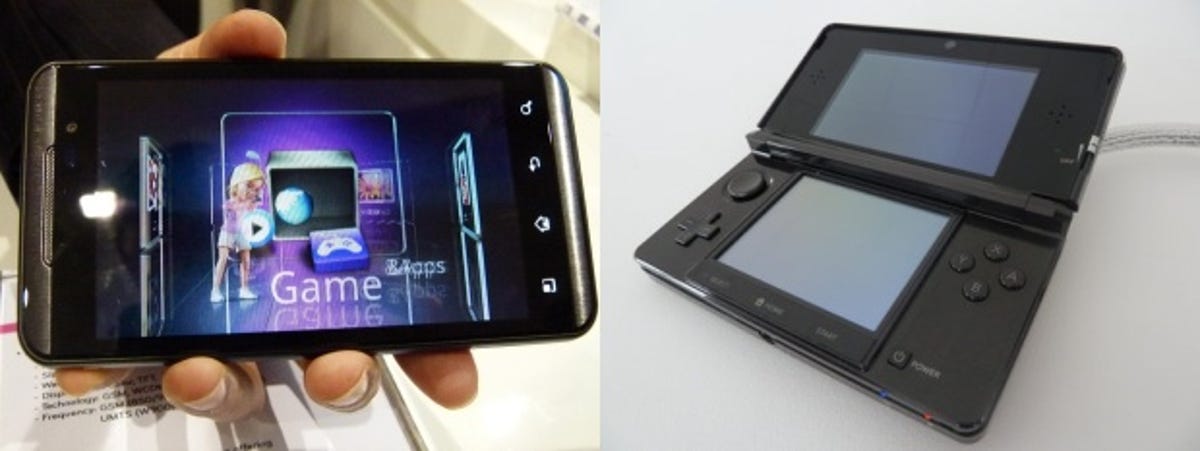
There’s this little thing that’s pretty big in tech at the moment. 3D — perhaps you’ve heard of it? We’ve gone way beyond the geeky specs 3D of last year, and now all the coolest upcoming gadgets are sporting glasses-free 3D technology.
The Nintendo 3DS was the device that started it all, but now LG is showing off the world’s first 3D smart phone, the LG Optimus 3D. We’ve gone hands- and eyes-on with both devices, but which one packs better 3D tech?
Science!
Both the 3DS and the Optimus 3D display their three-dimensional magic using something called a parallax barrier. That’s a slim extra layer on top of the display covered in tiny slits, which means light projected out the gadget’s screen is split into two separate paths of light.
Effectively these displays are showing two images at once. Line your peepers up with those beams of light, and you’ll get a stereoscopic image, without having to wear any dorky glasses.
The downside is you do have to keep your eyes locked in that rather specific spot. If your head leaves the sweet spot, the illusion vanishes faster than a bunch of tech journalists when it’s time to settle the bar tab.
Hit the spot
Having used both devices, we reckon the 3DS is more generous when it comes to that sweet spot. You’re not to going to fit more than one person around the console enjoying the 3D effect, but you can tilt the 3DS a good inch or so to the left or right without breaking the spell. The Optimus 3D’s sweet spot is very tight, and moving your head (or the phone) just a little will turn the 3D image into a blurry mess.
That’s more of a problem for the Optimus 3D, and here’s why: loads of mobile games use a smart phone’s built-in accelerometer to control the action, so you tilt the phone itself to affect what happens on-screen. But tilting the Optimus 3D even a little will break the 3D effect. Hardly ideal.
The 3DS has an accelerometer too, and we know there are games coming out that use it, and we imagine these titles will suffer from the same problem. But the 3DS crucially is controlled mostly through buttons, or through the lower touchscreen panel, meaning most games won’t require you to jig the console itself around very much.
Strong contenders
We’ve been blown away by the 3D effect on both devices. 3D content effectively halves the resolution of whatever’s on screen (because the maximum potential resolution is divided between each eye) but everything we saw still looked pleasingly sharp and bright.
The depth of the effect is extremely impressive, with objects in the foreground seemingly popping out of the screen, and background objects genuinely feeling much further away. It’s great fun, and both devices handle the effect with aplomb.
Neither sacrifice 2D imaging either — the standard Android menu on the Optimus 3D isn’t in 3D, but it doesn’t suffer from having a 3D-capable display, looking bright and sharp at all times. The 3DS has a slider control to the right of the top panel that lets you dial down the 3D effect (or turn it up), which is impressive, and means you can switch to 2D whenever you want without having to go through loads of menus. Games played on the Optimus 3D have an on-screen slider that serves the same purpose.
Deeper than 3D
So in terms of just 3D, we reckon the 3DS has the Optimus 3D beat. Just. But there are a tonne of other great things about the Optimus 3D — it’s a powerful Android phone for cryin’ out loud!
It’s got calls, a powerful Web browser with Flash support, access to the Android Market — where you can download thousands of dirt cheap (or free) games — and it has two 5-megapixel cameras for taking 3D photos, or capturing 3D footage in 720p. Videos can be uploaded to YouTube’s 3D channel, and to top it all off there’s a dual-core processor under the hood for running intensive apps and games.
But that has to be balanced against what’s sure to be a bumped-up price. If you want a supremely capable smart phone and have the cash to spare, the Optimus 3D brings the 3D funtimes admirably. If you want to enjoy 3D a little more affordably, the 3DS might have fewer features, but we know it’s still going to be incredibly enjoyable — you almost certainly won’t get Mario Kart, Zelda and Pilotwings on the LG.



